Cardinal Ruffo and the Pro-Bourbon Uprising
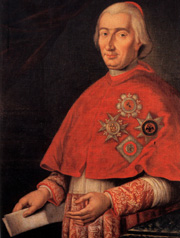
He is the protagonist of exceptional Italian deeds that have been concealed for decades by Italian Historiography and only now have begun to be revealed to the general public thanks to the contribution of many historians who, for the sake of truth, published studies and organised meetings on the occasion of the bicentenary of those events.
In reality, the history of Italian popular uprisings against the Napoleonic invader and his Italian allies the Republican Jacobins, does not concern only the
Kingdom of Naples; in fact it was the last one to be invaded in December 1798.
In the previous three years, tenths of thousands of Italians from all social classes had already fought against the revolutionists to defend the Church and their lawful sovereigns and governs. Many studies describing with relative preciseness these tragic and heroic events are now available and we refer the reader to them for any in-depth study of this very important page in the history of Italian populations.
Here we just mention in a very short but clear way the most glorious and triumphal implications in the history of Italian counterrevolutionary uprisings: the events occurred in the Kingdom of Naples in 1799 and between 1806 and 1810.
A Populace in Revolt in the Name of Ferdinand IV
Napoleon Bonaparte invaded Italy in 1796, entering Piedmont and marching towards Lombardy and Veneto. His was a lightening conquest, but what is not so well known is that the populace revolutionists rose up everywhere to defend the Italian traditions against the French and Jacobin Republics. So in 1796-’97 Northern Italy revolted, in 1798 the revolt interested the territories of the Pontifical State that the French invaded in February; and the same happened in 1799 in the Kingdom of Naples and in the rest of Italy, which would be freed completely in October 1799 by a general counterrevolution of the Italian populace (from the Alps to Calabria) in the name of Catholic religion and their respective lawful sovereigns and governs.
In the Kingdom of Naples, from February 1798 the Pontifical State had disappeared; in its stead the Roman Jacobin Republic had been established, but during all the subsequent months, tenths of thousands of people rose up in the name of Pius VI who had been forced to leave Rome. In November 1798 Ferdinand IV decided to attack the Roman Republic, restore the sovereign Pontiff on his lawful Throne and expel Jacobinism and the Napoleonic invaders from the entire Peninsula.
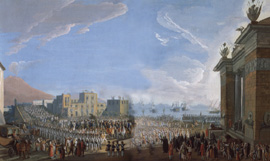
Attacked from the south, Napoleon’s general Championnet at first withdrew his troops and allowed King Ferdinand IV to enter Rome in triumph (the population welcomed him in general exultation); then he counterattacked; at this point the Neapolitan Army was not able to resist and hastened back to Naples, always avoiding any battle and surrendering without even fighting all the strongholds of the northern territories of the Kingdom, including the impregnable fortress of Gaeta.
On 8 December 1798, Ferdinand IV issued an official proclamation from L’Aquila and invited all his subjects to rise up and defend their Kingdom and their Religion against the revolutionary invaders. No proclamation was ever literally applied as that one. While calmly marching to Naples with three different armies, Championnet met the unexpected and ferocious resistance of the insurgent Abruzzi and south Lazio populations. These tens of thousands of people ready to made the most heroic deeds delayed of many weeks the arrival of the French in Naples. Michele Pezza from Itri, called “Fra Diavolo” (Friar Devil), the most famous and courageous of all the insurgent leaders of those years, fought Jacobinism since the very first days of the French invasion and would give his life to serve the Catholic and Bourbon cause. However, on 22 December King Ferdinand and all his Court left Naples by sea to reach Palermo since he had to take the sea because he had been betrayed on land (he referred to the clear betrayal of the highest ranks of his army, starting from Mack himself, who had left the Kingdom in the hands of the invaders without fighting).
Naples remained in the hands of Vicar Pignatelli Strongoli, who later was deprived of power by the Corp of the Elected, an ancient aristocratic body in which towered young Antonio Capece Minutolo prince of Canosa, tireless upholder (for all his life) of the Bourbon legitimacy; but in reality, in January anarchy ruled the capital, especially when the French were gradually approaching it. To the news that also the stronghold of Capua surrendered to the Napoleonic forces without fighting, the “Lazzari” (Lazzaroni) – tens of thousands of Neapolitan members of the lower classes – took over the control of the city, ready to fight to death against local French and Jacobin allied to defend their Throne and their religion.
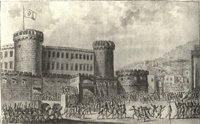
The Lazzari revolt began on 13 January 1799 and forced the Neapolitan democrats to take refuge in the strongholds of the capital. When Championnet decided to attack Naples, the Lazzaroni began a heroic and impossible resistance that lasted until 23 January and caused 10,000 casualties among the Neapolitans and 1,000 among the French. On 21 January, while the entire city was fighting, and dying, against the French, a few Jacobins shut in Castel S.Elmo proclaimed the official birth of the Neapolitan Republic.
At the end Championnet conquered the city (it took him three French armies to defeat the popular resistance and he had to committed to the atrocity of setting fire to the houses to force the people to come out and then he shot them) [Regarding the Lazzari, always portrayed as fanatical and uncouth persons by all the 20th century national historiography, General Championnet said the following: “No fight was ever tougher: no scenario more frightful. The Lazzaroni, these wonderful people (…) are heroes closed in Naples. They fight along all streets; they contend for their territory inch by inch. The Lazzaroni are led by brave leaders. S. Elmo Fort kills them; the terrible bayonet knocks them down; they withdraw in order, charge again, boldly advance, often gain ground…”. General Bonnamy said the same: “the Lazzaroni, these wonderful people, fight as lions. They are knocked down, they win. Despite they loose ground and artillery, we conquer streets, surround them, we cannot subdue them. The night falls, the fire goes on (…) The day arises: the fury of the fighters doubles. Both sides show great valour”. These are the opinions on the Lazzari expressed by the Napoleonic generals.]
In the days that followed the taking of Naples and the establishment of the Jacobin Republic, a Catholic Cardinal, prince and member of one of the most ancient families of the Kingdom, Fabrizio Ruffo of the Dukes of Baranello and Bagnara, at that time director of S. Leucio Colony, took the initiative of going to Palermo to ask the King men and vessels to reconquer the Kingdom. We will never know what pushed Ruffo to do this and what exactly he had in mind. He wasn’t a general, but only a noble priest, as there were many in those days. What is sure is that, once he arrived in Palermo and spoke to the sovereigns, he got the title of plenipotentiary Vicar of the King, a vessel and seven men.
He set off with what he had and on 7 February 1799 he landed in Calabria at Pizzo, near the fiefs of his family. There was just the eight of them. Four months later, the army formed by volunteers of the Holy Faith (Ruffo called his army “The Army of the Holy Faith” or “Catholic and Royal Army”), or Sanfedists, counted tens of thousands of people, entered Naples in triumph and restored the Bourbon monarchy. This is undoubtedly the most heroic page of all the history of the Italian Counterrevolution and most probably among the most moving ones. For these reasons, facing these events no one could remain unmoved: either they had to be celebrated as they deserved or defamed and reappraised. In the past two centuries, and especially in the last one, Italian historiography chose the latter. Of course, it is not possible to relate to the historical events of that expedition. Here we would just mention that, while in the northern provinces of the Kingdom thousands of peoples had already risen up spontaneously as soon as Ferdinand issued the proclamation of general defence of the Kingdom on 8 December 1798, Cardinal Ruffo began his reconquest of Calabria in April, and only in May did he move north, touching Matera and then Altamura and afterwards reaching Manfredonia and Ariano, where he arrived on 5 June and got ready to march on the capital. He took the capital after a tragic battle that saw the Neapolitan Lazzari again in action on 13 June, the very day dedicated to Saint Anthony, official Patron Saint of the “Catholic and Royal Army”.
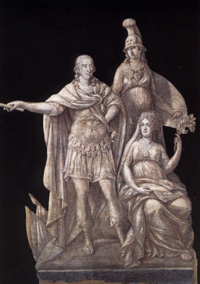
In those days, during the siege of Naples, he tried to save the Jacobins shut in Castel S. Elmo, and therefore he offered them a way to escape via land; but they preferred to trust in Nelson, who was besieging Naples from the sea; Nelson had 99 of them hanged, and from this ruthless action the myth of the “Martyrs of the Neapolitan Republic” stemmed out and the fault has always been wrongly given to the Bourbon. Although the King could have perhaps been more merciful and spared some of them, it’s very unlikely he cou-ld hd saved from capital punishment those who were guilty of high treason, who had conspired with a revolutionary invader and caused the fall of the Monarchy and the Kingdom in the hands of the enemy, and, moreover, who had done this without the least support of the people, even against the people’s will (not only the citizens of Naples), as the previous months had shown unequivocally.
If we really want to be impartial in giving an historical judgement, we must bear in mind the real seriousness of the Jacobins’ treason both towards the lawful sovereigns and towards the people of the Kingdom; this seriousness was even worsened by the fact that they gave the State in the hands of an invader enemy and, most of all, to the sovereigns these traitors were mostly noble people and often friends of the royal couple and had received benefits from them.
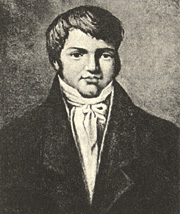
If we could have an instantaneous overview of the Kingdom of Naples in the first six months of 1799, we would see tens of thousands of people rise up voluntarily from Abruzzo and southern Lazio to Apulia and Calabria and fight to death against the Jacobin Republic and the Napoleonic invader in the name of the Church and the Bourbon Two Sicilies. Just to mention a few names among the most famous heads of pro-Bourbon rising we should list Fra Diavolo (Friar Devil), G.B. Rodio, Giuseppe Pronio, Vito Nunziante [In ’99 Nunziante set up a regiment at his own costs to fight against the French; Ferdinand esteemed him so much that during the Restoration he was appointed as Viceroy of Sicily.], Sciarpa, Panedigrano, etc. We must also mention the great war fought from 1806 to 1810 by the French against the so-called southern pro-Bourbon “Brigandage” to support first Joseph Bonaparte and then Joachim Murat on the Throne of Naples.
It is a tragic history, characterised by bloody massacres, unscrupulous retaliations, dramatic and rude events. Apulia, Basilicata and especially Calabria rose up and created a real situation of permanent war. The insurgents, led by some heroes of ’99 (again, Michele Pezza [We remind everybody that Ferdinand gave Pezza the title of Duke and a rich pension for his merits; but in 1806 Pezza left his title, pension, wife and children to fight again against the French and died as a hero after declining the proposal made by Joseph Bonaparte to serve him, save his life and obtain more prestigious and higher tasks.], Sciabolone, De Donatis, G.B. Rodio [The Queen liked Rodio very much and appointed him Marquis for his devotion to the cause for which in the end he gave his life, as did Fra Diavolo, in 1806.], Sciarpa, Panedigrano, the protagonists of the Holy Faith (Sanfedists) who after seven years did not hesitate to leave again their families and jobs and all the privileges acquired to face death in a desperate war only to serve the same cause as seven years before, the same King against the same enemy), plus other new counterrevolutionary exponents among which I mention Carmine Caligiuri, Rodolfo Mirabelli, Alessandro Mandarini and others. Supported by the British via sea, they faced for years the French-Neapolitan armies and were engaged in real battles “on a grand scale”, such as the one they won at Maida. At the end they were defeated, but Murat never obtained peace and support from his subjects: as we already said when talking of Ferdinand IV, when Murat landed at Pizzo and attempted to reconquer the kingdom in 1815 was shot by local peasants, then arrested, processed and condemned to death.
The uprising was an exceptional occasion for many humble commoners to show their heroic loyalty to their sovereigns, as well as for others (nobles and lords) to show their treason to their sovereigns and benefactors.
Some considerations
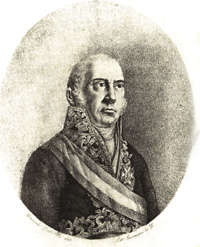
The trend applied by Italian historiography to all other heroic and tragic events of the Italian uprising – that occurred almost everywhere across the country in those 25 years – was that of “concealing” them. However, this was not possible for the Ruffo expedition and Sanfedismo due to the epochal dimensions of these phenomena and therefore in this case the trend was that of “calumniating” them: Ruffo’s followers where only bloodthirsty criminal and murderous gangs looking for easy plunder and Ruffo was the leader they deserved.
We cannot deny that among them there were real criminals and brigands too; and in fact the Cardinal was strongly annoyed by that and often adopted very strict measures to repress delinquent actions. He always did whatever he could also to save the Jacobins from the fury of his men, and it often occurred that the republicans gave themselves up to him to escape the revenge of Sanfedists.
But what else could we expect? On 7 February Cardinal Ruffo had only 7 men; two months later, tenths of thousands of volunteers had rushed to his help from all across the Kingdom. Of course, there were also disreputable persons among them, but these did not form the “core” of the Army of the Saint Faith. The core was formed by noblemen, peasants, officers, middle-class people, even priests ready to leave their families, churches and wealth to follow a Cardinal and fight against Jacobinism.
What historiography does not want to acknowledge here (and for this reason it always reports only the violent actions, be them real or invented) is the real motivation that pushed the majority of the population to join – directly or indirectly – Sanfedismo: i.e. their clear and even violent refusal of Jacobinism and its revolutionary ideas and therefore their loyalty to their Catholic faith and the Bourbon family. This is the heart of the matter, still aching today, after two hundred years.
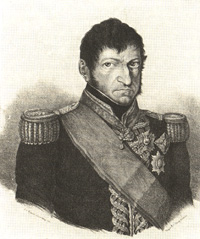
Neapolitan republicans could have even been unselfish (someone) and courageous (someone), many of them then met a tragic death, as we know, and paid their ideas with their own lives; we do not deny this. But why does historiography still deny that all the kingdom was anti-Jacobin? That the population was loyal to a traditional idea of Faith and Monarchy?
Just to make a few examples, here is a list of some data of cruel retaliations perpetrated by the Franco-Jacobin troops against unarmed and defenceless civilians (besides the already mentioned 10,000 Neapolitan casualties in the week of the Lazzaroni uprising): the first ferocious slaughters of civilians occurred in southern Lazio: 1,300 people were massacred at Isola Liri and in the nearby areas; Itri and Castelforte were devastated; 1,200 people were killed at Minturno in January, and other 800 in April; the inhabitants of Castellonorato were all massacred; 1,500 people were put to the sword in Isernia, 700 in the areas around Rieti, 700 at Guardiagrele, 4,000 at Andria, 2,000 in Trani, 3,000 in S. Severo, 800 at Carbonara, the entire population of Ceglie, etc.; still in 1806-10, in the war of Calabria, we recall 2,200 people killed in Amantea, 300 at Longobardi, etc.
The French General Thiébou [General P. THIÉBOULT wrote in his Mémoires (Paris, 1894, II, p. 325): “without considering the casualties suffered in the fights, more than 60,000 of them were killed on the ruins of their cities or over the ashes of their huts”. In: N. RODOLICO, Il popolo agli inizi del Risorgimento nell’Italia meridionale (1798-1801), Le Monnier, Firenze 1926, pp. XIII-XIV.] gave a total of 60,000 civilians (and civilians only) massacred by the Franco-Jacobin army in the five months of the Republic!
To conclude, these well-known events show that the Italian population, and in particular the southern population, refused the French Revolution in the name of their loyalty to their tradition and lawful governs. This is the real background of the heroic deeds of the Saint Faith: the population was against the Jacobins and loyal to the Bourbon monarchy.





